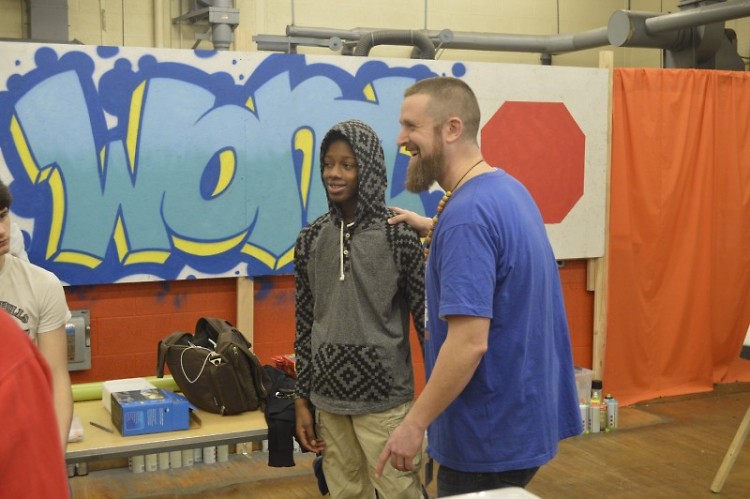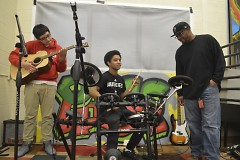Matthew Duncan lightly shakes a can of spray paint and, like the serious aerosol artist he is, deftly sprays an immaculate orange “o” on a canvas.
And so begins a lesson on graffiti – or more properly called “writing,” he tells students gathered in a former wood shop at Ottawa Hills High School. They’ve come here to learn not just about graffiti, but about emceeing (motivational rapping), break dancing, deejaying and knowledge – all elements of hip-hop culture -- from masters like Duncan, aka Monk Mattheus, his hip-hop name.
“Nice circle!” Duncan tells sophomore Christopher Garcia, who’s sprayed a thicker and larger shape on the canvas. “You’re kind of far away though.”
Three more students try their hand, still too fat and far away. Then Daniel Arellano and Draven Larrick zero in with smaller, well-defined circles. “There you go, there you go!” Duncan says encouragingly.
In this new after-school program, OHHS students learn the fine points of hip-hop as well as its larger aims. Social justice, self-confidence and self-expression were hip-hop’s historical hallmarks and have much to offer today’s young people, says Duncan, an OHHS graduate.
“Because hip-hop is a culture, not a style of music, the purpose of that culture when it came into being was to better the community,” says Duncan, a hip-hop veteran who is at home with two turntables and a microphone. “That’s what has become lost once rap music became a product that was bought and sold.
“We’re trying to get that mindset away from the kids,” he adds. Hip-hop, he says, is “something that you are. It’s something that you live. The way that you approach and see the world is what hip-hop is.”
Teaching life and job skills
Working with fellow hip-hop artists, Duncan launched the program this semester as an outreach of All of the Above Creative, a Lansing-based organization founded by recording artist Ozay Moore. AOTA aims to empower youth by equipping them with artistic, leadership and business skills to contribute to their communities.
Duncan directs the group’s Grand Rapids chapter, having immersed himself in the hip-hop scene since graduating from OHHS in 1995. He performed with the Grand Rapids group The Swollen Headz, then moved in 2002 to Miami where he continued performing and became involved with Preserving, Archiving and Teaching Hip Hop (PATH), which supports youth in underserved communities.
Having returned to Grand Rapids in 2013, Duncan last fall approached Assistant Principal Bradley Lundvick with the idea of an after-school program. He also offered $15,000 worth of musical equipment donated by The Haven, a now-closed program of the Kent County Juvenile Detention Center where Duncan had volunteered. Duncan’s idea seemed well-suited to Ottawa’s abandoned wood shop, now outfitted with a drum kit, recording studio, a break-dance floor and loudly colored graffiti murals.
The school considers it an extracurricular program for students with musical and artistic interests, Lundvick says.
“There’s a lot of community support in the hip-hop community in Grand Rapids, especially around Ottawa Hills,” Lundvick says, noting other volunteers are also OHHS grads. “We feel very lucky to have these guys be able to teach their craft and their skills to our kids.”
About 10 to 15 students come to the twice-weekly sessions, where they learn about hip-hop history and philosophy as well as specific skills. Duncan hopes to develop the pilot program into a for-credit high school course for GRPS or other districts.
The program ties into academics, life and job skills while providing a way for students to tell their stories. It has much broader job benefits than just the hip-hop industry, says Duncan, who works for a prosthetics manufacturer: “We want you to be able to be a quality person, get a quality job, raise a quality family, and do it all as a hip-hop cultural (person).”
History against violence
His volunteer crew includes Kamau Williams, a deejay who works the turntables while Michael Taylor teaches students break-dance moves. Taylor opens a recent session by giving them a short history of hip hop and how it originated as a way to quell gang violence, establish safe zones and improve communities.
“Breaking, deejays, all this stuff still has to apply to your everyday lives,” Taylor tells them.
Duncan gives them an overview of the many kinds of graffiti writing, from a tag to a “burner,” and the difference between art and vandalism.
“I’m not a criminal, I’m an artist,” he says. “There are rules to graffiti. You cannot just go paint anywhere you want.”
Freshman Draven Larrick works by herself on her writing style, while her older brother Trevor, who goes by “Twitch,” practices his break dancing. “When it comes to breaking, you don’t have to think of what you do,” the senior says. “You just do it.”
Bagir “Bach” Mohamed, a sophomore, loves the poetry of emceeing, but has also discovered new things his body can do.
“I always thought of myself as a dancer, but I didn’t have enough confidence to try and do it,” he says. “This kind of brings it out.”
The Rapidian, a program of the 501(c)3 nonprofit Community Media Center, relies on the community’s support to help cover the cost of training reporters and publishing content.
We need your help.
If each of our readers and content creators who values this community platform help support its creation and maintenance, The Rapidian can continue to educate and facilitate a conversation around issues for years to come.
Please support The Rapidian and make a contribution today.

